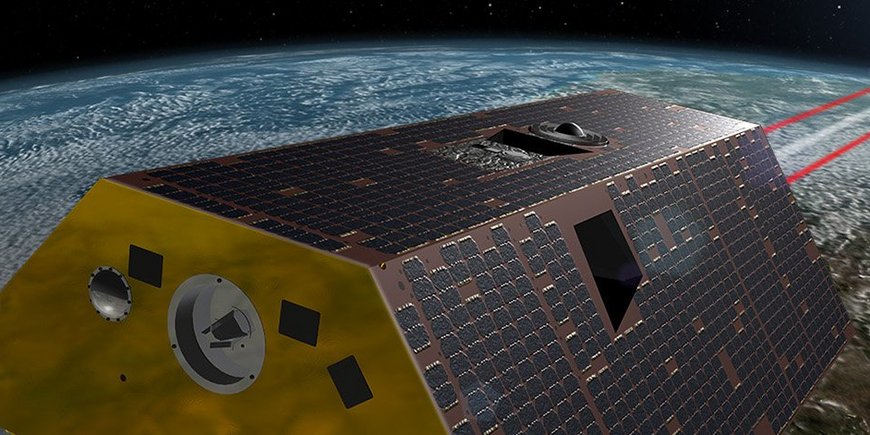The Gravity Recovery and Climate Experiment Follow-On (GRACE-FO) mission team plans to switch to a backup system in the microwave instrument on one of the twin spacecraft this month. Following the switch-over, GRACE-FO is expected to quickly resume science data collection.
A month after its May launch, GRACE-FO produced its first preliminary gravity field map. The mission has not acquired science data since mid-July due to an anomaly with a component of the microwave instrument on one of the GRACE-FO spacecraft. The mission team is completing its investigation into the cause of the anomaly.
The GRACE-FO spacecraft were launched on a SpaceX Falcon 9 rocket on May 22. The mission’s launch and early operations phases were completed within five days and the science instruments were activated a few days later. Analysis of the initial data indicated that both the Microwave Instrument (MWI) and the Laser Ranging Interferometer (LRI) were producing highly precise measurements of the gravity-induced change in distance between the two GRACE-FO satellites – as good as or better than the original GRACE mission.
On July 19, the primary MWI Instrument Processing Unit (IPU) on the GRACE-FO 2 satellite powered down in response to autonomous commands from an instrument fault monitor which indicated that the IPU was using less current than expected. The IPU provides various timing references for the satellite, as well as on-board digital signal-processing functions for the MWI and GPS signals. Each of the two GRACE-FO satellites is equipped with a pair of IPUs -- a primary unit and a redundant one -- to provide backup in case one unit malfunctions.
Following several unsuccessful attempts to reactivate the IPU, JPL established an anomaly response team on Aug. 6 to investigate the issue. The team is working with the engineers who developed the MWI, attempting to reproduce the abnormal behavior in the laboratory to understand the cause of the problem.
Following completion of the remaining instrument calibrations, the performance and stability of the redundant IPU will be monitored for at least 30 days. Once the instrument’s stable operation is confirmed, the mission will be on track to enter its science operations phase beginning with a four-month data-validation period as previously planned.
The primary science objective of GRACE-FO, like its predecessor GRACE, is to track how water is redistributed on Earth by producing highly accurate, monthly gravity field maps. Measurements of changes in the Earth’s gravity field provide measurements of mass change and enable unique insights into Earth's changing climate, Earth system processes like droughts and sea level changes, and the impacts of human activities on water resources.
GRACE-FO is a partnership between NASA and the GeoForschungsZentrum (GFZ). The operation of the two satellites is subcontracted by the GFZ to the German Aerospace Center (DLR) by the German Space Operations Center in Oberpfaffenhofen. NASA's Jet Propulsion Laboratory (JPL) is the overall project leader. The scientific evaluation is done jointly by GFZ, JPL and the Center for Space Research of the University of Austin / Texas (UTCSR).
|Updated 19.9.2018, 10:00 am|
For more information about GRACE-FO, see:








![[Translate to English:] Torsten Sachs in front of a climate station on a field](/fileadmin/_processed_/3/9/csm__TorstenSachs_bearbeitet_GS_4a1365ef84.jpeg)

![[Translate to English:] left image flood at the Ahrtal: image from above, several houses are flooded; left image:: Heidi Kreibich;](/fileadmin/_processed_/4/4/csm_Bild2_9af0130e9f.png)



![[Translate to English:] Start der Vega Rakete](/fileadmin/_processed_/6/4/csm_20231201-kachel_Vega-VV23-launch_ESA-CNES-Arianespace_706716b68c.jpeg)









![[Translate to English:] Poster exhibition at the Brandenburg Hydrogen Day at the GFZ, some participants in the foreground](/fileadmin/_processed_/6/5/csm_Erster_Brandenburgischer_Wasserstofftag_GFZ_402fcec95e.jpeg)
![[Translate to English:] Group picture of the participants](/fileadmin/_processed_/9/4/csm_20231108_CAWa-Workshop-Tashkent_Gruppenbild_99ea779d8a.jpeg)

![[Translate to English:] [Translate to English:] Hörsaal](/fileadmin/_processed_/e/6/csm_H%C3%B6rsal_e21ac645fb.jpeg)


![[Translate to English:] The Delegations in the Historic Library on the Telegrafenberg. In the back there are from left to right, the Dutch Ambassador for Germany, Ronald van Roeden, the Dutch Minister for Education, Culture and Science, Robbert Dijkgraaf and the scientific director of the GFZ, Susanne Buiter.](/fileadmin/_processed_/d/b/csm_Kachel-2_9eba4b4212.jpeg)

